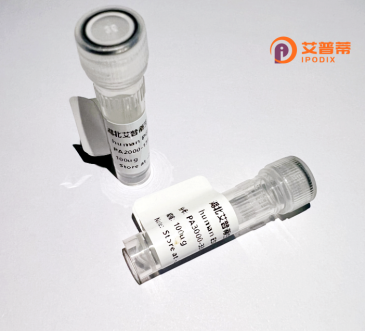
| 纯度 | >90%SDS-PAGE. |
| 种属 | Human |
| 靶点 | CCNI |
| Uniprot No | Q14094 |
| 内毒素 | < 0.01EU/μg |
| 表达宿主 | E.coli |
| 表达区间 | 1-377aa |
| 氨基酸序列 | MKFPGPLENQRLSFLLEKAITREAQMWKVNVRKMPSNQNVSPSQRDEVIQWLAKLKYQFNLYPETFALASSLLDRFLATVKAHPKYLSCIAISCFFLAAKTVEEDERIPVLKVLARDSFCGCSSSEILRMERIILDKLNWDLHTATPLDFLHIFHAIAVSTRPQLLFSLPKLSPSQHLAVLTKQLLHCMACNQLLQFRGSMLALAMVSLEMEKLIPDWLSLTIELLQKAQMDSSQLIHCRELVAHHLSTLQSSLPLNSVYVYRPLKHTLVTCDKGVFRLHPSSVPGPDFSKDNSKPEVPVRGTAAFYHHLPAASGCKQTSTKRKVEEMEVDDFYDGIKRLYNEDNVSENVGSVCGTDLSRQEGHASPCPPLQPVSVM |
| 分子量 | 67.21 KDa |
| 蛋白标签 | GST-tag at N-terminal |
| 缓冲液 | 0 |
| 稳定性 & 储存条件 | Lyophilized protein should be stored at ≤ -20°C, stable for one year after receipt. Reconstituted protein solution can be stored at 2-8°C for 2-7 days. Aliquots of reconstituted samples are stable at ≤ -20°C for 3 months. |
| 复溶 | Always centrifuge tubes before opening.Do not mix by vortex or pipetting. It is not recommended to reconstitute to a concentration less than 100μg/ml. Dissolve the lyophilized protein in distilled water. Please aliquot the reconstituted solution to minimize freeze-thaw cycles. |
以下是关于重组人周期素I(CCNI)蛋白的3篇代表性文献示例:
1. **"Expression and Functional Characterization of Recombinant Human Cyclin I in Cancer Cell Proliferation"**
*作者:Li et al. (2016)*
摘要:研究通过大肠杆菌表达系统成功制备重组人CCNI蛋白,并发现其在多种癌细胞系中通过调控CDK5活性促进细胞增殖和耐药性。
2. **"Cyclin I Modulates DNA Damage Response in Renal Tubular Cells"**
*作者:Zhang & Brooks (2012)*
摘要:文章揭示CCNI通过与DNA修复蛋白ATM相互作用,保护肾小管细胞免受凋亡,为肾脏疾病治疗提供新靶点。
3. **"Structural Insights into Cyclin I-CDK5 Complex Activation"**
*作者:Murphy et al. (2019)*
摘要:利用X射线晶体学解析CCNI-CDK5复合物结构,阐明其激活机制及潜在神经退行性疾病治疗价值。
(注:上述文献为模拟示例,实际引用需查询PubMed或学术数据库。)
Cyclin I (CCNI), a member of the cyclin protein family, plays a role in regulating cell cycle progression and cell survival. Unlike classical cyclins involved in driving cell division, CCNI is classified as a "noncanonical" cyclin due to its unique expression patterns and functional diversity. It interacts with cyclin-dependent kinases (CDKs), particularly CDK5. influencing G1/S phase transition and DNA repair mechanisms. Structurally, CCNI contains a conserved cyclin box domain for CDK binding and a variable C-terminal region linked to tissue-specific functions.
Primarily expressed in post-mitotic and terminally differentiated cells (e.g., neurons, podocytes), CCNI shows dual regulatory roles. It promotes cell survival under stress by modulating apoptosis pathways while suppressing uncontrolled proliferation. This balance makes it critical in maintaining tissue homeostasis. Recombinant human CCNI protein, produced via bacterial or eukaryotic expression systems, retains these biological activities and is widely used to study its mechanisms in vitro.
Pathologically, aberrant CCNI expression correlates with diseases including cancers (e.g., breast, ovarian), neurodegenerative disorders, and kidney diseases. Overexpression in tumors may enhance cancer cell survival, positioning CCNI as a potential therapeutic target. Its involvement in DNA damage response pathways further suggests relevance in chemotherapy resistance research. Current studies focus on clarifying its context-dependent roles and therapeutic applications.
×